Do you have a question about the Hitachi PC-ARFG-E and is the answer not in the manual?
Hazards or unsafe practices resulting in severe personal injury or death.
Practices causing minor personal injury or property damage.
Important recommendations for safe installation and operation.
Notes on CD-ROM, backlight behavior, and button handling.
Procedures for starting and stopping the air conditioner unit.
Steps for basic controller power-on and switching between settings.
Explanation of available operating modes like Cool, Heat, Dry, Auto, and Fan.
Instructions for adjusting temperature, including min/max limits.
How to adjust fan speed settings.
How to set the louver direction and swing.
Notes on icon display dependency and priority.
Notes on function availability and menu display.
Steps to access and navigate the function menu.
How to set a simple timer for unit start or stop.
Setting daily operation schedules for unit start/stop and temperature.
Setting the desired time and temperature for schedules.
Temporarily preventing schedules from running.
Setting specific days as holidays to skip scheduled operations.
Deleting all schedule and holiday settings.
Detailed steps to set schedule day, time, and temperature.
Notes on scheduled operation availability and date/time setting.
Enabling or disabling scheduled operations.
Setting holidays to skip scheduled operations.
Note on schedule indicator for holiday setting.
Resetting all schedule and holiday settings to default.
Overview of power saving modes available.
Notes on power savings mode availability and settings.
Selecting and configuring power savings modes.
Turning the power savings function on or off.
Setting the level of power savings (Low, Med, High).
Restricting outdoor unit operation noise.
Notes on Night Quiet operation availability and noise reduction.
Setting schedules for power saving and noise reduction.
Setting the desired time and level for schedules.
Enabling or disabling the schedule function.
Notes on managing multiple schedules and overlapping times.
Setting the day, time, and level for power saving/night quiet schedules.
Note on schedule control availability and date/time setting.
Enabling or disabling power saving/night quiet schedules.
Displaying outdoor unit compressor power consumption.
Notes on using the display for reference only and unsupported functions.
Setting the Quick mode for faster temperature attainment.
Notes on Autoboost availability and fan speed behavior.
Menu for various comfort-related settings.
Controlling discharge air temperature in cooling mode for comfort.
Notes on GentleCool function availability and temperature settings.
Setting individual louver direction for optimal airflow.
Using radiant sensor to optimize heating.
Increasing ambient temperature near feet to reduce room temperature unevenness.
Adjusting airflow to prevent discomfort from overcooling at floor level.
Settings for units equipped with a motion sensor.
Selecting modes for motion sensor activation.
Safety precautions for using the motion sensor function.
Defining unit operation mode when motion sensor detects absence.
Setting the time interval for detecting absence.
Maintaining comfort in unoccupied rooms.
Setting schedules for setback operation.
Notes on schedule operation availability.
Temporarily activating setback operation manually.
Note on setback operation availability.
Raising and lowering the grille for cleaning.
Notes on enabling and using the elevating grille function.
Turning off filter reminder and resetting filter usage time.
Function for cleaning the indoor unit heat exchanger coil.
Information about FrostWash operation, noise, and conditions.
Steps to start the FrostWash cleaning cycle.
Note on avoiding grill removal during FrostWash.
Configuring FrostWash settings on the outdoor unit.
Notes on FrostWash function limitations and requirements.
Description of the Auto-FrostWash operation sequence.
Accessing and performing FrostWash settings.
Enabling or disabling the automatic FrostWash function.
Note on icon disappearance during Auto-FrostWash.
Setting the time intervals for FrostWash operation.
Scheduling automatic FrostWash operations.
Viewing and deleting FrostWash operation history.
Notes on history display and deletion.
Screens displayed during FrostWash operation.
Notes on screen display and backlight behavior.
Individually setting the air direction of multiple outlets.
Notes on function availability and conditions.
Note on flashing unit display.
Cancelling individual louver direction settings.
Note on flashing unit display.
Note that all individual louver settings are cancelled.
Fully opening air louvers to identify a specific unit.
Notes on function availability and conditions.
Selecting ventilation operation modes.
Note on function availability.
Changing the ventilation mode of the total heat exchanger.
Note on function availability.
Reducing cooling load by exhausting hot air at night.
Menu for initial installation and setup procedures.
Performing a test run to verify installation.
Selecting and configuring various unit functions.
Selecting the sensor for indoor temperature control.
Notes on sensor control and its interaction with parameter C8.
Configuring input/output settings for indoor units.
Calibrating the remote controller's temperature sensor.
Setting fan speed during cooling Thermo-OFF.
Notes on shortcut function and fan stopping.
Setting fan speed during heating Thermo-OFF.
Notes on shortcut function and fan stopping.
Changing the address of indoor units.
Notes on refrigerant system number and address range.
Checking and operating individual indoor units by address.
Initializing indoor unit addresses to factory defaults.
Notes on successful address changes and initialization compatibility.
Restoring factory default settings for Function Selection and Input/Output.
Notes on initialization compatibility and potential issues.
Setting the primary remote controller for a system.
Notes on controller settings and availability.
Procedure to change a sub controller to the main controller.
Setting priority for operation mode and temperature.
Notes on default priority setting and compatibility.
Cancelling the compressor preheating function.
Warning against cancelling preheating during normal operation.
Activating the elevating grille function for cleaning access.
Steps to set the elevating grille function for units.
Cancelling the elevating grille settings.
Setting maximum compressor frequency for faster operation.
Setting the unit that triggers setback operation.
Configuring settings for the refrigerant leak sensor.
Resetting the refrigerant leak sensor alarm.
Performing test run operations for the sensor.
Resetting the refrigerant leak display.
Resetting the integration time for sensor activation.
Displaying real-time indoor unit operating parameters.
Displaying recorded parameters before the last alarm.
Accessing service functions and settings.
Locking or unlocking unit operation settings.
Changing or resetting the user password.
Enabling or disabling the hotel mode setting.
Detailed settings for various power saving functions.
Setting permissible temperature ranges for operation.
Setting specific temperature points for cooling and heating modes.
Controlling the display of main/sub controller settings.
Registering installation location names for controllers.
Registering service contact details for the controller.
Displaying operating times and maintenance data.
Accessing various diagnostic and status check menus.
Detailed steps for checking operational data.
Viewing and deleting the history of alarms.
Displaying model name and manufacturing number.
Performing self-checks on indoor and outdoor unit PCBs.
Initiating controller checkout and resetting settings.
Checking the software version and clearing EEPROM.
Testing the LCD display and screen colors.
Checking backlight brightness.
Checking the run indicator lights.
Testing all switch inputs.
Notes on switch pressing and counting.
Testing the buzzer volume.
Checking transmission between controller and units.
Displaying remote controller thermistor temperature.
Checking the real-time clock.
Checking flash memory.
Note on checking process progression.
Checking and clearing EEPROM data.
Note on checking process progression.
Process for clearing and restarting EEPROM.
Notes on saving settings and time accuracy.
Setting the current date and time.
Notes on time adjustment from sub controllers.
Setting the time format (24-hour or 12-hour).
Adjusting time for daylight savings.
Adjusting the brightness of the run indicator.
Adjusting backlight brightness and off time.
Note on maximum backlight brightness.
Adjusting the backlight brightness level.
Setting the time before the backlight turns off.
Settings related to temperature display and units.
Changing temperature unit and display width.
Showing or hiding the thermistor temperature display.
Changing the displayed language of the controller.
Adjusting the sound volume for keypad presses.
Selecting the display language for the controller.
Setting the timer to turn off the air conditioner.
Notes on off timer settings.
Resetting controller settings to default values.
Actions to take during and after a power failure.
Information on interference and unit response.
Hazards or unsafe practices resulting in severe personal injury or death.
Practices causing minor personal injury or property damage.
Important recommendations for safe installation and operation.
Notes on CD-ROM, backlight behavior, and button handling.
Procedures for starting and stopping the air conditioner unit.
Steps for basic controller power-on and switching between settings.
Explanation of available operating modes like Cool, Heat, Dry, Auto, and Fan.
Instructions for adjusting temperature, including min/max limits.
How to adjust fan speed settings.
How to set the louver direction and swing.
Notes on icon display dependency and priority.
Notes on function availability and menu display.
Steps to access and navigate the function menu.
How to set a simple timer for unit start or stop.
Setting daily operation schedules for unit start/stop and temperature.
Setting the desired time and temperature for schedules.
Temporarily preventing schedules from running.
Setting specific days as holidays to skip scheduled operations.
Deleting all schedule and holiday settings.
Detailed steps to set schedule day, time, and temperature.
Notes on scheduled operation availability and date/time setting.
Enabling or disabling scheduled operations.
Setting holidays to skip scheduled operations.
Note on schedule indicator for holiday setting.
Resetting all schedule and holiday settings to default.
Overview of power saving modes available.
Notes on power savings mode availability and settings.
Selecting and configuring power savings modes.
Turning the power savings function on or off.
Setting the level of power savings (Low, Med, High).
Restricting outdoor unit operation noise.
Notes on Night Quiet operation availability and noise reduction.
Setting schedules for power saving and noise reduction.
Setting the desired time and level for schedules.
Enabling or disabling the schedule function.
Notes on managing multiple schedules and overlapping times.
Setting the day, time, and level for power saving/night quiet schedules.
Note on schedule control availability and date/time setting.
Enabling or disabling power saving/night quiet schedules.
Displaying outdoor unit compressor power consumption.
Notes on using the display for reference only and unsupported functions.
Setting the Quick mode for faster temperature attainment.
Notes on Autoboost availability and fan speed behavior.
Menu for various comfort-related settings.
Controlling discharge air temperature in cooling mode for comfort.
Notes on GentleCool function availability and temperature settings.
Setting individual louver direction for optimal airflow.
Using radiant sensor to optimize heating.
Increasing ambient temperature near feet to reduce room temperature unevenness.
Adjusting airflow to prevent discomfort from overcooling at floor level.
Settings for units equipped with a motion sensor.
Selecting modes for motion sensor activation.
Safety precautions for using the motion sensor function.
Defining unit operation mode when motion sensor detects absence.
Setting the time interval for detecting absence.
Maintaining comfort in unoccupied rooms.
Setting schedules for setback operation.
Notes on schedule operation availability.
Temporarily activating setback operation manually.
Note on setback operation availability.
Raising and lowering the grille for cleaning.
Notes on enabling and using the elevating grille function.
Turning off filter reminder and resetting filter usage time.
Function for cleaning the indoor unit heat exchanger coil.
Information about FrostWash operation, noise, and conditions.
Steps to start the FrostWash cleaning cycle.
Note on avoiding grill removal during FrostWash.
Configuring FrostWash settings on the outdoor unit.
Notes on FrostWash function limitations and requirements.
Description of the Auto-FrostWash operation sequence.
Accessing and performing FrostWash settings.
Enabling or disabling the automatic FrostWash function.
Note on icon disappearance during Auto-FrostWash.
Setting the time intervals for FrostWash operation.
Scheduling automatic FrostWash operations.
Viewing and deleting FrostWash operation history.
Notes on history display and deletion.
Screens displayed during FrostWash operation.
Notes on screen display and backlight behavior.
Individually setting the air direction of multiple outlets.
Notes on function availability and conditions.
Note on flashing unit display.
Cancelling individual louver direction settings.
Note on flashing unit display.
Note that all individual louver settings are cancelled.
Fully opening air louvers to identify a specific unit.
Notes on function availability and conditions.
Selecting ventilation operation modes.
Note on function availability.
Changing the ventilation mode of the total heat exchanger.
Note on function availability.
Reducing cooling load by exhausting hot air at night.
Menu for initial installation and setup procedures.
Performing a test run to verify installation.
Selecting and configuring various unit functions.
Selecting the sensor for indoor temperature control.
Notes on sensor control and its interaction with parameter C8.
Configuring input/output settings for indoor units.
Calibrating the remote controller's temperature sensor.
Setting fan speed during cooling Thermo-OFF.
Notes on shortcut function and fan stopping.
Setting fan speed during heating Thermo-OFF.
Notes on shortcut function and fan stopping.
Changing the address of indoor units.
Notes on refrigerant system number and address range.
Checking and operating individual indoor units by address.
Initializing indoor unit addresses to factory defaults.
Notes on successful address changes and initialization compatibility.
Restoring factory default settings for Function Selection and Input/Output.
Notes on initialization compatibility and potential issues.
Setting the primary remote controller for a system.
Notes on controller settings and availability.
Procedure to change a sub controller to the main controller.
Setting priority for operation mode and temperature.
Notes on default priority setting and compatibility.
Cancelling the compressor preheating function.
Warning against cancelling preheating during normal operation.
Activating the elevating grille function for cleaning access.
Steps to set the elevating grille function for units.
Cancelling the elevating grille settings.
Setting maximum compressor frequency for faster operation.
Setting the unit that triggers setback operation.
Configuring settings for the refrigerant leak sensor.
Resetting the refrigerant leak sensor alarm.
Performing test run operations for the sensor.
Resetting the refrigerant leak display.
Resetting the integration time for sensor activation.
Displaying real-time indoor unit operating parameters.
Displaying recorded parameters before the last alarm.
Accessing service functions and settings.
Locking or unlocking unit operation settings.
Changing or resetting the user password.
Enabling or disabling the hotel mode setting.
Detailed settings for various power saving functions.
Setting permissible temperature ranges for operation.
Setting specific temperature points for cooling and heating modes.
Controlling the display of main/sub controller settings.
Registering installation location names for controllers.
Registering service contact details for the controller.
Displaying operating times and maintenance data.
Accessing various diagnostic and status check menus.
Detailed steps for checking operational data.
Viewing and deleting the history of alarms.
Displaying model name and manufacturing number.
Performing self-checks on indoor and outdoor unit PCBs.
Initiating controller checkout and resetting settings.
Checking the software version and clearing EEPROM.
Testing the LCD display and screen colors.
Checking backlight brightness.
Checking the run indicator lights.
Testing all switch inputs.
Notes on switch pressing and counting.
Testing the buzzer volume.
Checking transmission between controller and units.
Displaying remote controller thermistor temperature.
Checking the real-time clock.
Checking flash memory.
Note on checking process progression.
Checking and clearing EEPROM data.
Note on checking process progression.
Process for clearing and restarting EEPROM.
Notes on saving settings and time accuracy.
Setting the current date and time.
Notes on time adjustment from sub controllers.
Setting the time format (24-hour or 12-hour).
Adjusting time for daylight savings.
Adjusting the brightness of the run indicator.
Adjusting backlight brightness and off time.
Note on maximum backlight brightness.
Adjusting the backlight brightness level.
Setting the time before the backlight turns off.
Settings related to temperature display and units.
Changing temperature unit and display width.
Showing or hiding the thermistor temperature display.
Changing the displayed language of the controller.
Adjusting the sound volume for keypad presses.
Selecting the display language for the controller.
Setting the timer to turn off the air conditioner.
Notes on off timer settings.
Resetting controller settings to default values.
Actions to take during and after a power failure.
Information on interference and unit response.
| Brand | Hitachi |
|---|---|
| Model | PC-ARFG-E |
| Category | Remote Control |
| Compatibility | Hitachi Air Conditioners |
| Power Source | 2 x AAA Batteries |
| Display | LCD |
| Range | Up to 10 meters |
| Type | Remote Control |
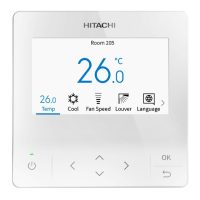
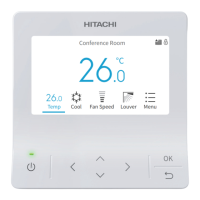
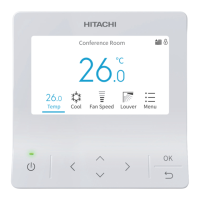
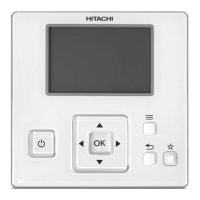
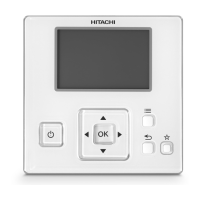
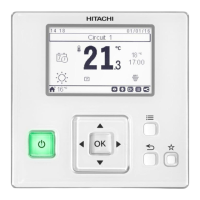
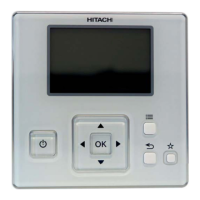
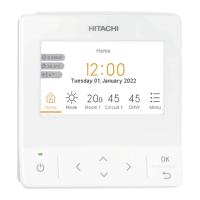
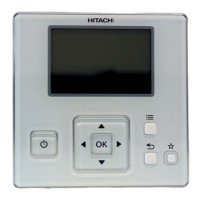
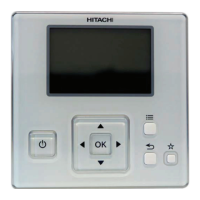

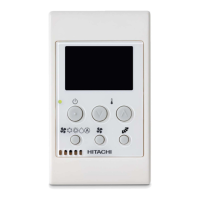
